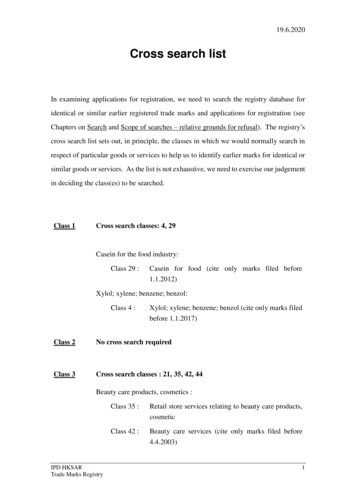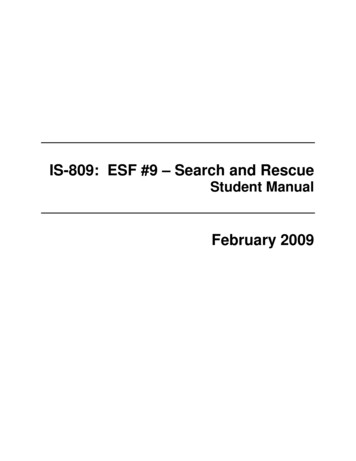
Transcription
In Search of an Understandable Consensus Algorithm(Extended Version)Diego Ongaro and John OusterhoutStanford UniversityAbstractstate space reduction (relative to Paxos, Raft reduces thedegree of nondeterminism and the ways servers can be inconsistent with each other). A user study with 43 studentsat two universities shows that Raft is significantly easierto understand than Paxos: after learning both algorithms,33 of these students were able to answer questions aboutRaft better than questions about Paxos.Raft is similar in many ways to existing consensus algorithms (most notably, Oki and Liskov’s ViewstampedReplication [29, 22]), but it has several novel features: Strong leader: Raft uses a stronger form of leadership than other consensus algorithms. For example,log entries only flow from the leader to other servers.This simplifies the management of the replicated logand makes Raft easier to understand. Leader election: Raft uses randomized timers toelect leaders. This adds only a small amount ofmechanism to the heartbeats already required for anyconsensus algorithm, while resolving conflicts simply and rapidly. Membership changes: Raft’s mechanism forchanging the set of servers in the cluster uses a newjoint consensus approach where the majorities oftwo different configurations overlap during transitions. This allows the cluster to continue operatingnormally during configuration changes.We believe that Raft is superior to Paxos and other consensus algorithms, both for educational purposes and as afoundation for implementation. It is simpler and more understandable than other algorithms; it is described completely enough to meet the needs of a practical system;it has several open-source implementations and is usedby several companies; its safety properties have been formally specified and proven; and its efficiency is comparable to other algorithms.The remainder of the paper introduces the replicatedstate machine problem (Section 2), discusses the strengthsand weaknesses of Paxos (Section 3), describes our general approach to understandability (Section 4), presentsthe Raft consensus algorithm (Sections 5–8), evaluatesRaft (Section 9), and discusses related work (Section 10).Raft is a consensus algorithm for managing a replicatedlog. It produces a result equivalent to (multi-)Paxos, andit is as efficient as Paxos, but its structure is differentfrom Paxos; this makes Raft more understandable thanPaxos and also provides a better foundation for building practical systems. In order to enhance understandability, Raft separates the key elements of consensus, such asleader election, log replication, and safety, and it enforcesa stronger degree of coherency to reduce the number ofstates that must be considered. Results from a user studydemonstrate that Raft is easier for students to learn thanPaxos. Raft also includes a new mechanism for changingthe cluster membership, which uses overlapping majorities to guarantee safety.1 IntroductionConsensus algorithms allow a collection of machinesto work as a coherent group that can survive the failures of some of its members. Because of this, they play akey role in building reliable large-scale software systems.Paxos [15, 16] has dominated the discussion of consensus algorithms over the last decade: most implementationsof consensus are based on Paxos or influenced by it, andPaxos has become the primary vehicle used to teach students about consensus.Unfortunately, Paxos is quite difficult to understand, inspite of numerous attempts to make it more approachable.Furthermore, its architecture requires complex changesto support practical systems. As a result, both systembuilders and students struggle with Paxos.After struggling with Paxos ourselves, we set out tofind a new consensus algorithm that could provide a better foundation for system building and education. Our approach was unusual in that our primary goal was understandability: could we define a consensus algorithm forpractical systems and describe it in a way that is significantly easier to learn than Paxos? Furthermore, we wantedthe algorithm to facilitate the development of intuitionsthat are essential for system builders. It was important notjust for the algorithm to work, but for it to be obvious whyit works.The result of this work is a consensus algorithm calledRaft. In designing Raft we applied specific techniques toimprove understandability, including decomposition (Raftseparates leader election, log replication, and safety) and2 Replicated state machinesConsensus algorithms typically arise in the context ofreplicated state machines [37]. In this approach, state machines on a collection of servers compute identical copiesof the same state and can continue operating even if someof the servers are down. Replicated state machines areThis tech report is an extended version of [32]; additional material isnoted with a gray bar in the margin. Published May 20, 2014.1
tency of the logs: faulty clocks and extreme messagedelays can, at worst, cause availability problems. In the common case, a command can complete assoon as a majority of the cluster has responded to asingle round of remote procedure calls; a minority ofslow servers need not impact overall system performance.3 What’s wrong with Paxos?Over the last ten years, Leslie Lamport’s Paxos protocol [15] has become almost synonymous with consensus:it is the protocol most commonly taught in courses, andmost implementations of consensus use it as a startingpoint. Paxos first defines a protocol capable of reachingagreement on a single decision, such as a single replicatedlog entry. We refer to this subset as single-decree Paxos.Paxos then combines multiple instances of this protocol tofacilitate a series of decisions such as a log (multi-Paxos).Paxos ensures both safety and liveness, and it supportschanges in cluster membership. Its correctness has beenproven, and it is efficient in the normal case.Unfortunately, Paxos has two significant drawbacks.The first drawback is that Paxos is exceptionally difficult to understand. The full explanation [15] is notoriously opaque; few people succeed in understanding it, andonly with great effort. As a result, there have been severalattempts to explain Paxos in simpler terms [16, 20, 21].These explanations focus on the single-decree subset, yetthey are still challenging. In an informal survey of attendees at NSDI 2012, we found few people who were comfortable with Paxos, even among seasoned researchers.We struggled with Paxos ourselves; we were not able tounderstand the complete protocol until after reading several simplified explanations and designing our own alternative protocol, a process that took almost a year.We hypothesize that Paxos’ opaqueness derives fromits choice of the single-decree subset as its foundation.Single-decree Paxos is dense and subtle: it is divided intotwo stages that do not have simple intuitive explanationsand cannot be understood independently. Because of this,it is difficult to develop intuitions about why the singledecree protocol works. The composition rules for multiPaxos add significant additional complexity and subtlety.We believe that the overall problem of reaching consensuson multiple decisions (i.e., a log instead of a single entry)can be decomposed in other ways that are more direct andobvious.The second problem with Paxos is that it does not provide a good foundation for building practical implementations. One reason is that there is no widely agreedupon algorithm for multi-Paxos. Lamport’s descriptionsare mostly about single-decree Paxos; he sketched possible approaches to multi-Paxos, but many details are missing. There have been several attempts to flesh out and optimize Paxos, such as [26], [39], and [13], but these differFigure 1: Replicated state machine architecture. The consensus algorithm manages a replicated log containing statemachine commands from clients. The state machines processidentical sequences of commands from the logs, so they produce the same outputs.used to solve a variety of fault tolerance problems in distributed systems. For example, large-scale systems thathave a single cluster leader, such as GFS [8], HDFS [38],and RAMCloud [33], typically use a separate replicatedstate machine to manage leader election and store configuration information that must survive leader crashes. Examples of replicated state machines include Chubby [2]and ZooKeeper [11].Replicated state machines are typically implementedusing a replicated log, as shown in Figure 1. Each serverstores a log containing a series of commands, which itsstate machine executes in order. Each log contains thesame commands in the same order, so each state machine processes the same sequence of commands. Sincethe state machines are deterministic, each computes thesame state and the same sequence of outputs.Keeping the replicated log consistent is the job of theconsensus algorithm. The consensus module on a serverreceives commands from clients and adds them to its log.It communicates with the consensus modules on otherservers to ensure that every log eventually contains thesame requests in the same order, even if some servers fail.Once commands are properly replicated, each server’sstate machine processes them in log order, and the outputs are returned to clients. As a result, the servers appearto form a single, highly reliable state machine.Consensus algorithms for practical systems typicallyhave the following properties: They ensure safety (never returning an incorrect result) under all non-Byzantine conditions, includingnetwork delays, partitions, and packet loss, duplication, and reordering. They are fully functional (available) as long as anymajority of the servers are operational and can communicate with each other and with clients. Thus, atypical cluster of five servers can tolerate the failureof any two servers. Servers are assumed to fail bystopping; they may later recover from state on stablestorage and rejoin the cluster. They do not depend on timing to ensure the consis2
from each other and from Lamport’s sketches. Systemssuch as Chubby [4] have implemented Paxos-like algorithms, but in most cases their details have not been published.Furthermore, the Paxos architecture is a poor one forbuilding practical systems; this is another consequence ofthe single-decree decomposition. For example, there is little benefit to choosing a collection of log entries independently and then melding them into a sequential log; thisjust adds complexity. It is simpler and more efficient todesign a system around a log, where new entries are appended sequentially in a constrained order. Another problem is that Paxos uses a symmetric peer-to-peer approachat its core (though it eventually suggests a weak form ofleadership as a performance optimization). This makessense in a simplified world where only one decision willbe made, but few practical systems use this approach. If aseries of decisions must be made, it is simpler and fasterto first elect a leader, then have the leader coordinate thedecisions.As a result, practical systems bear little resemblanceto Paxos. Each implementation begins with Paxos, discovers the difficulties in implementing it, and then develops a significantly different architecture. This is timeconsuming and error-prone, and the difficulties of understanding Paxos exacerbate the problem. Paxos’ formulation may be a good one for proving theorems about its correctness, but real implementations are so different fromPaxos that the proofs have little value. The following comment from the Chubby implementers is typical:There were numerous points in the design of Raftwhere we had to choose among alternative approaches.In these situations we evaluated the alternatives based onunderstandability: how hard is it to explain each alternative (for example, how complex is its state space, and doesit have subtle implications?), and how easy will it be for areader to completely understand the approach and its implications?We recognize that there is a high degree of subjectivity in such analysis; nonetheless, we used two techniquesthat are generally applicable. The first technique is thewell-known approach of problem decomposition: wherever possible, we divided problems into separate piecesthat could be solved, explained, and understood relativelyindependently. For example, in Raft we separated leaderelection, log replication, safety, and membership changes.Our second approach was to simplify the state spaceby reducing the number of states to consider, making thesystem more coherent and eliminating nondeterminismwhere possible. Specifically, logs are not allowed to haveholes, and Raft limits the ways in which logs can becomeinconsistent with each other. Although in most cases wetried to eliminate nondeterminism, there are some situations where nondeterminism actually improves understandability. In particular, randomized approaches introduce nondeterminism, but they tend to reduce the statespace by handling all possible choices in a similar fashion(“choose any; it doesn’t matter”). We used randomizationto simplify the Raft leader election algorithm.5 The Raft consensus algorithmThere are significant gaps between the description ofthe Paxos algorithm and the needs of a real-worldsystem. . . . the final system will be based on an unproven protocol [4].Raft is an algorithm for managing a replicated log ofthe form described in Section 2. Figure 2 summarizes thealgorithm in condensed form for reference, and Figure 3lists key properties of the algorithm; the elements of thesefigures are discussed piecewise over the rest of this section.Raft implements consensus by first electing a distinguished leader, then giving the leader complete responsibility for managing the replicated log. The leader acceptslog entries from clients, replicates them on other servers,and tells servers when it is safe to apply log entries totheir state machines. Having a leader simplifies the management of the replicated log. For example, the leader candecide where to place new entries in the log without consulting other servers, and data flows in a simple fashionfrom the leader to other servers. A leader can fail or become disconnected from the other servers, in which casea new leader is elected.Given the leader approach, Raft decomposes the consensus problem into three relatively independent subproblems, which are discussed in the subsections that follow: Leader election: a new leader must be chosen whenan existing leader fails (Section 5.2). Log replication: the leader must accept log entriesBecause of these problems, we concluded that Paxosdoes not provide a good foundation either for systembuilding or for education. Given the importance of consensus in large-scale software systems, we decided to seeif we could design an alternative consensus algorithmwith better properties than Paxos. Raft is the result of thatexperiment.4 Designing for understandabilityWe had several goals in designing Raft: it must providea complete and practical foundation for system building,so that it significantly reduces the amount of design workrequired of developers; it must be safe under all conditionsand available under typical operating conditions; and itmust be efficient for common operations. But our mostimportant goal—and most difficult challenge—was understandability. It must be possible for a large audience tounderstand the algorithm comfortably. In addition, it mustbe possible to develop intuitions about the algorithm, sothat system builders can make the extensions that are inevitable in real-world implementations.3
StateRequestVote RPCPersistent state on all servers:(Updated on stable storage before responding to RPCs)currentTermlatest term server has seen (initialized to 0on first boot, increases monotonically)votedForcandidateId that received vote in currentterm (or null if none)log[]log entries; each entry contains commandfor state machine, and term when entrywas received by leader (first index is 1)Invoked by candidates to gather votes (§5.2).Volatile state on all servers:commitIndexindex of highest log entry known to becommitted (initialized to 0, increasesmonotonically)lastAppliedindex of highest log entry applied to statemachine (initialized to 0, erm, for candidate to update itselftrue means candidate received voteRules for ServersFollowers (§5.2): Respond to RPCs from candidates and leaders If election timeout elapses without receiving AppendEntriesRPC from current leader or granting vote to candidate:convert to candidateAppendEntries RPCleaderCommitResults:termvoteGrantedAll Servers: If commitIndex lastApplied: increment lastApplied, applylog[lastApplied] to state machine (§5.3) If RPC request or response contains term T currentTerm:set currentTerm T, convert to follower (§5.1)Invoked by leader to replicate log entries (§5.3); also used asheartbeat (§5.2).prevLogTermentries[]candidate’s termcandidate requesting voteindex of candidate’s last log entry (§5.4)term of candidate’s last log entry (§5.4)Receiver implementation:1. Reply false if term currentTerm (§5.1)2. If votedFor is null or candidateId, and candidate’s log is atleast as up-to-date as receiver’s log, grant vote (§5.2, §5.4)Volatile state on leaders:(Reinitialized after election)nextIndex[]for each server, index of the next log entryto send to that server (initialized to leaderlast log index 1)matchIndex[]for each server, index of highest log entryknown to be replicated on server(initialized to 0, increases idates (§5.2): On conversion to candidate, start election: Increment currentTerm Vote for self Reset election timer Send RequestVote RPCs to all other servers If votes received from majority of servers: become leader If AppendEntries RPC received from new leader: convert tofollower If election timeout elapses: start new electionleader’s termso follower can redirect clientsindex of log entry immediately precedingnew onesterm of prevLogIndex entrylog entries to store (empty for heartbeat;may send more than one for efficiency)leader’s commitIndexLeaders: Upon election: send initial empty AppendEntries RPCs(heartbeat) to each server; repeat during idle periods toprevent election timeouts (§5.2) If command received from client: append entry to local log,respond after entry applied to state machine (§5.3) If last log index nextIndex for a follower: sendAppendEntries RPC with log entries starting at nextIndex If successful: update nextIndex and matchIndex forfollower (§5.3) If AppendEntries fails because of log inconsistency:decrement nextIndex and retry (§5.3) If there exists an N such that N commitIndex, a majorityof matchIndex[i] N, and log[N].term currentTerm:set commitIndex N (§5.3, §5.4).currentTerm, for leader to update itselftrue if follower contained entry matchingprevLogIndex and prevLogTermReceiver implementation:1. Reply false if term currentTerm (§5.1)2. Reply false if log doesn’t contain an entry at prevLogIndexwhose term matches prevLogTerm (§5.3)3. If an existing entry conflicts with a new one (same indexbut different terms), delete the existing entry and all thatfollow it (§5.3)4. Append any new entries not already in the log5. If leaderCommit commitIndex, set commitIndex min(leaderCommit, index of last new entry)Figure 2: A condensed summary of the Raft consensus algorithm (excluding membership changes and log compaction). The serverbehavior in the upper-left box is described as a set of rules that trigger independently and repeatedly. Section numbers such as §5.2indicate where particular features are discussed. A formal specification [31] describes the algorithm more precisely.4
Election Safety: at most one leader can be elected in agiven term. §5.2Leader Append-Only: a leader never overwrites or deletesentries in its log; it only appends new entries. §5.3Log Matching: if two logs contain an entry with the sameindex and term, then the logs are identical in all entriesup through the given index. §5.3Leader Completeness: if a log entry is committed in agiven term, then that entry will be present in the logsof the leaders for all higher-numbered terms. §5.4State Machine Safety: if a server has applied a log entryat a given index to its state machine, no other serverwill ever apply a different log entry for the same index.§5.4.3Figure 4: Server states. Followers only respond to requestsfrom other servers. If a follower receives no communication,it becomes a candidate and initiates an election. A candidatethat receives votes from a majority of the full cluster becomesthe new leader. Leaders typically operate until they fail.Figure 3: Raft guarantees that each of these properties is trueat all times. The section numbers indicate where each property is discussed.from clients and replicate them across the cluster,forcing the other logs to agree with its own (Section 5.3). Safety: the key safety property for Raft is the StateMachine Safety Property in Figure 3: if any serverhas applied a particular log entry to its state machine,then no other server may apply a different commandfor the same log index. Section 5.4 describes howRaft ensures this property; the solution involves anadditional restriction on the election mechanism described in Section 5.2.After presenting the consensus algorithm, this section discusses the issue of availability and the role of timing in thesystem.Figure 5: Time is divided into terms, and each term beginswith an election. After a successful election, a single leadermanages the cluster until the end of the term. Some electionsfail, in which case the term ends without choosing a leader.The transitions between terms may be observed at differenttimes on different servers.will begin shortly. Raft ensures that there is at most oneleader in a given term.Different servers may observe the transitions betweenterms at different times, and in some situations a servermay not observe an election or even entire terms. Termsact as a logical clock [14] in Raft, and they allow serversto detect obsolete information such as stale leaders. Eachserver stores a current term number, which increasesmonotonically over time. Current terms are exchangedwhenever servers communicate; if one server’s currentterm is smaller than the other’s, then it updates its currentterm to the larger value. If a candidate or leader discoversthat its term is out of date, it immediately reverts to follower state. If a server receives a request with a stale termnumber, it rejects the request.Raft servers communicate using remote procedure calls(RPCs), and the basic consensus algorithm requires onlytwo types of RPCs. RequestVote RPCs are initiated bycandidates during elections (Section 5.2), and AppendEntries RPCs are initiated by leaders to replicate log entries and to provide a form of heartbeat (Section 5.3). Section 7 adds a third RPC for transferring snapshots betweenservers. Servers retry RPCs if they do not receive a response in a timely manner, and they issue RPCs in parallelfor best performance.5.1 Raft basicsA Raft cluster contains several servers; five is a typicalnumber, which allows the system to tolerate two failures.At any given time each server is in one of three states:leader, follower, or candidate. In normal operation thereis exactly one leader and all of the other servers are followers. Followers are passive: they issue no requests ontheir own but simply respond to requests from leadersand candidates. The leader handles all client requests (ifa client contacts a follower, the follower redirects it to theleader). The third state, candidate, is used to elect a newleader as described in Section 5.2. Figure 4 shows thestates and their transitions; the transitions are discussedbelow.Raft divides time into terms of arbitrary length, asshown in Figure 5. Terms are numbered with consecutiveintegers. Each term begins with an election, in which oneor more candidates attempt to become leader as describedin Section 5.2. If a candidate wins the election, then itserves as leader for the rest of the term. In some situationsan election will result in a split vote. In this case the termwill end with no leader; a new term (with a new election)5.2 Leader electionRaft uses a heartbeat mechanism to trigger leader election. When servers start up, they begin as followers. Aserver remains in follower state as long as it receives valid5
RPCs from a leader or candidate. Leaders send periodicheartbeats (AppendEntries RPCs that carry no log entries)to all followers in order to maintain their authority. If afollower receives no communication over a period of timecalled the election timeout, then it assumes there is no viable leader and begins an election to choose a new leader.To begin an election, a follower increments its currentterm and transitions to candidate state. It then votes foritself and issues RequestVote RPCs in parallel to each ofthe other servers in the cluster. A candidate continues inthis state until one of three things happens: (a) it wins theelection, (b) another server establishes itself as leader, or(c) a period of time goes by with no winner. These outcomes are discussed separately in the paragraphs below.A candidate wins an election if it receives votes froma majority of the servers in the full cluster for the sameterm. Each server will vote for at most one candidate in agiven term, on a first-come-first-served basis (note: Section 5.4 adds an additional restriction on votes). The majority rule ensures that at most one candidate can win theelection for a particular term (the Election Safety Property in Figure 3). Once a candidate wins an election, itbecomes leader. It then sends heartbeat messages to all ofthe other servers to establish its authority and prevent newelections.While waiting for votes, a candidate may receive anAppendEntries RPC from another server claiming to beleader. If the leader’s term (included in its RPC) is at leastas large as the candidate’s current term, then the candidaterecognizes the leader as legitimate and returns to followerstate. If the term in the RPC is smaller than the candidate’scurrent term, then the candidate rejects the RPC and continues in candidate state.The third possible outcome is that a candidate neitherwins nor loses the election: if many followers becomecandidates at the same time, votes could be split so thatno candidate obtains a majority. When this happens, eachcandidate will time out and start a new election by incrementing its term and initiating another round of RequestVote RPCs. However, without extra measures split votescould repeat indefinitely.Raft uses randomized election timeouts to ensure thatsplit votes are rare and that they are resolved quickly. Toprevent split votes in the first place, election timeouts arechosen randomly from a fixed interval (e.g., 150–300ms).This spreads out the servers so that in most cases only asingle server will time out; it wins the election and sendsheartbeats before any other servers time out. The samemechanism is used to handle split votes. Each candidaterestarts its randomized election timeout at the start of anelection, and it waits for that timeout to elapse beforestarting the next election; this reduces the likelihood ofanother split vote in the new election. Section 9.3 showsthat this approach elects a leader rapidly.Figure 6: Logs are composed of entries, which are numberedsequentially. Each entry contains the term in which it wascreated (the number in each box) and a command for the statemachine. An entry is considered committed if it is safe for thatentry to be applied to state machines.Elections are an example of how understandabilityguided our choice between design alternatives. Initiallywe planned to use a ranking system: each candidate wasassigned a unique rank, which was used to select betweencompeting candidates. If a candidate discovered anothercandidate with higher rank, it would return to followerstate so that the higher ranking candidate could more easily win the next election. We found that this approachcreated subtle issues around availability (a lower-rankedserver might need to time out and become a candidateagain if a higher-ranked server fails, but if it does so toosoon, it can reset progress towards electing a leader). Wemade adjustments to the algorithm several times, but aftereach adjustment new corner cases appeared. Eventuallywe concluded that the randomized retry approach is moreobvious and understandable.5.3 Log replicationOnce a leader has been elected, it begins servicingclient requests. Each client request contains a command tobe executed by the replicated state machines. The leaderappends the command to its log as a new entry, then issues AppendEntries RPCs in parallel to each of the otherservers to replicate the entry. When the entry has beensafely replicated (as described below), the leader appliesthe entry to its state machine and returns the result of thatexecution to the client. If followers crash or run slowly,or if network packets are lost, the leader retries AppendEntries RPCs indefinitely (even after it has responded tothe client) until all followers eventually store all log entries.Logs are organized as shown in Figure 6. Each log entry stores a state machine command along with the termnumber when the entry was received by the leader. Theterm numbers in log entries are used to detect inconsistencies between logs and to ensure some of the propertiesin Figure 3. Each log entry also has an integer index iden6
tifying its position in the log.The leader decides when it is safe to apply a log entry to the state machines; such an entry is called committed. Raft guarantees that committed entries are durableand will eventually be executed by all of the availables
demonstrate that Raft is easier for students to learn than Paxos. Raft also includes a new mechanism for changing the cluster membership, which uses overlapping majori-ties to guarantee safety. 1 Introduction Consensus algorithms allow a collection of machines to work as a coherent group that can survive the fail-ures of some of its members.











